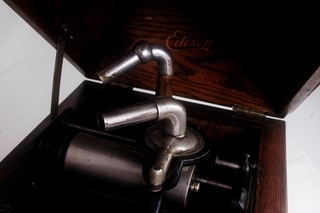Fonógrafo
Among the various experiments carried out in the 19th. c. to record sound vibrations, the creation of the phonoautographe by Eduard León Scott was considered one of the most important. This machine, which was a direct precursor of the phonograph, was invented in 1857. it consisted of a stylus attached to a membrane which transmitted the sounds received by a conical metal horn and registered them in a paper covered with lampblack placed on a revolving cylinder. In April 1877, Charles Cros (French) sent a report to the Académie des Sciences of his country, describing a machine similar to that of Scott's but which could also reproduce the sound recorded. Cros could never make the machine he had designed.
In December of same year, Thomas Alva Edison (American) made the first phonograph. It consisted of a speaking tube attached to a diaphragm with a metal needle. This needle rested on a tin foil which covered a cylinder with spiral grooves. While the cylinder moved round an axis set in motion by a crank, the sound waves made the diaphragm vibrate. At the same time, the needle pushed the tin into the cylinder grooves whose depth depended on the vibration range.
When the cylinder was placed at the starting point again and the needle moved in the groove, the reverse process occurred and the vibrations recorded were reproduced.
Although this machine aroused great admiration, the faulty sonorous results discouraged Edison from trying to improve it.
In 1886, Graham Bell and his partners (Chister A. Bell and Charles Sumner Tainter) introduced significant changes in a new model whose trade name was graphophone. This new machine awakened Edison's interest again and in 1888 he presented his perfectionated phonograph. In such phonograph, the tin foil had been replaced by a wax solid cylinder. The rotation, which was fixed, was achieved by means of an electric engine and the diaphragm was the one to revolve the Amberola VIII was one of the various household instruments designed by Edison. It was made between 1913 and 1914 and was intended only for eproduction. This machine belonged to the series of economic models manufactured by the Company and its cost in the American market of that time was 45 dollars.
Its distinctive feature was the attachment of the metal horn to the oak cabinet.
Inscriptions: TRADE/Thomas A. Edison/MARK EDISON Amberola Vlll/MANUFACTURED BY/THOMAS A. EDISON, INC.
at Orange, N. J., U.S.A./PATENTED/OCT. 27, 1896. MAY31, 1898[...] SERIAL
NUMBER 7612[...¡
L. 41 x w. 33.8 x h. 39 cm.
Gift, Dr. Emilio Azzarini's, Collection, 1964. IM 451







